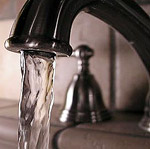The “Yerevan Water” company invited journalists and representatives of consumer interests’ protection NGOs Wednesday to show its newly purchased equipments and the work being implemented on Komitas avenue.
The company had chosen the section of the Mamikonyants street where there was work being done on the reconstruction of the broken-down water pipes to show the newly purchased equipment. They had placed that equipment at a short distance from the hole and explained what the equipment was capable of doing. As a matter of fact, director of “Yerevan Water”, Serge Popov, taking into account the complaints of the journalists regarding the tour, explained that he had chosen that place as the place to show the new equipment in order to make it more understandable. Whatever.
Popov informed that the company has purchased two units of German machinery that spot the loss of the flow of water, and each one of them costs 20 million drams. Company specialist Hamlet Saribekyan informed that the machinery was capable of determining which underground pipe has a hole or where the water is flowing from.
“Before we used to have similar machinery, but they couldn’t precisely determine from which pipe the water was flowing,” said Saribekyan. “This new equipment can even find the source of the water spraying out, regardless of how deep it is necessary to go, before reaching the pipe. This equipment is useful from the perspective of facilitating our work, quickly finding the loss of the flow of water, and seeing the water. True, we are presenting them now, but we procured the machinery seven months ago and have been using it ever since.”
The next stop was Komitas Boulevard. Those inviting us told us that they were changing the main water pipeline of the entire street, the pipes that serve the buildings, and the sewer line stretching 500 meters in length (a 5136-meter long pipe in total). Deputy head of the investment department of the company, Gagik Ayvazyan, informed that they have already changed 2300 meters of water lines. The work will probably end in September. Besides that, we found out that the reconstruction of the pipes is being implemented by the “Dorozhnik” company, which is also implementing the asphalting of Komitas Boulevard with funds provided by the “Lincy” fund. Ayvazyan mentioned that they had declared a competition for the reconstruction of the pipes and the “Dorozhnik” company had won.
Let us remind our readers that this is the “Dorozhnik” that cheerily wins all of the contests declared for road construction by chance. It is known that the representatives of the Karabakh branch of the authorities back this company. Let us recall that this is the company that implemented the Meghri-Kajaran road construction by way of the Shikahogh reserve. Let us not forget to recall that during the construction of that road the company director had moved the construction equipment into the reserve and threatened journalists and NGO representatives, saying “I will kill you all, do you know what back-up I have?” That is why “Dorozhnik” is able to “get” those kinds of large projects. Now that same company is also implementing the construction of the water lines of the “Yerevan Water” company along with the road construction of the “Lincy” project. That is, “Yerevan Water” has to pay 70 million drams to “Dorozhnik”. More than 107 million drams have been spent for the pipes and equipment for the 5136 meters of waterline. So, “Yerevan Water” has spent 177 million drams for the reconstruction of the water and sewer lines of Komitas Blvd. Journalists who had passed by the holes and pipes for months took a look at the construction being done on Wednesday, after which they had a chance to direct some questions to Serge Popov. Mr. Popov informed that water losses in the network range up to 80%, but they need to make it go down to 50% during the tenth year of the lease. According to the company director, 55-60% of the water loss is due to technical reasons and is a result of worn-out equipment. Another reason is commercial, in other words, the equipment left over is stolen. For purposes of comparison, the French director said that the losses of water in the water-supply network of Paris make up only 9-10%. In Paris the pipe is not underground, but rather stretches in the aboveground tunnel constructed especially for that purpose. It is clear that in such conditions the company in charge of the water supply may easily spot the damage and complete the restoration. Before the end of the contract the company has to increase water supply to 95%. In order to reach this goal, the productivity of the water supply network must be 50% instead of the current 20%. Mr. Popov also announced that this year the summer schedule for water supply will improve by 45% and water will be supplied for a longer time this summer, in contrast to summer 2006.

